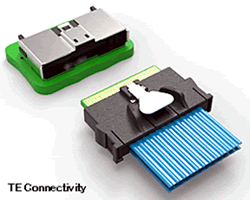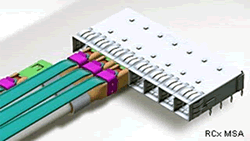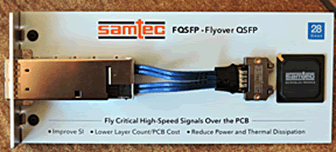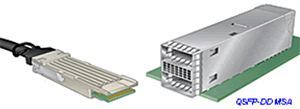Trends to improve speed, size and pricing continue
Connector makers upgraded lines, extended product families and unveiled new interfaces to meet customer demands for increased circuit density and higher data rates.
2016 Connector Trends
 In a continuation of trends we’ve seen for several years now, a host of faster, smaller, and more affordable electronic components propelled the connector industry forward in 2016. Connector manufacturers introduced a combination of upgrades and extensions to existing products and brought out entirely new interfaces that feature higher circuit density and/or data throughput. At the same time, the growth of multi-source agreements, industry standards organizations, and consortiums reflect the demand for electrically and mechanically identical components from multiple, competitive sources.
In a continuation of trends we’ve seen for several years now, a host of faster, smaller, and more affordable electronic components propelled the connector industry forward in 2016. Connector manufacturers introduced a combination of upgrades and extensions to existing products and brought out entirely new interfaces that feature higher circuit density and/or data throughput. At the same time, the growth of multi-source agreements, industry standards organizations, and consortiums reflect the demand for electrically and mechanically identical components from multiple, competitive sources.
System engineers are developing the expertise necessary to design successful 25+ Gb/s channels. This data rate target is quickly ratcheting up to 50 Gb/s. Adoption of PAM4 signaling as an alternative to NRZ allows higher data transfer rates using lower channel frequencies. Use of PAM4 signaling will buy more time before designers must face the signal integrity and reach limitations of copper channels.
System designers must optimize circuit design, which mandates modeling and simulation of every channel. As a result, manufacturers of high-performance connectors continue to expand the range of technical support to their customers. It has become standard to provide 3-D models, eye diagrams, and S-parameter data. Molex recently introduced their Channel Analysis Tool, which quickly predicts performance using pre-simulated models. Samtec’s new Silicon-to-Silicon System Optimization Microsite is a suite of online tools that allow electrical engineers to analyze the entire channel to maximize performance and minimize cost.
 Smaller mobile devices demand components that feature miniaturized profiles. TE Connectivity’s new Sliver and Molex’s new Nano-Pitch connectors are examples of high-speed/density interfaces that are capable of supporting multiple industry standards.
Smaller mobile devices demand components that feature miniaturized profiles. TE Connectivity’s new Sliver and Molex’s new Nano-Pitch connectors are examples of high-speed/density interfaces that are capable of supporting multiple industry standards.
Demand for higher I/O panel density continues to expand the alphabet of pluggable connectors, which now includes SFP, SFP+, QSFP, QSFP28, CXP, CDFP, and CFP4.
TE Connectivity’s new Micro QSFP connector addresses issues of speed (up to 28 Gb/s), thermal management, and size in a package that is 33% smaller than the standard QSFP interface.
 Amphenol FCI and JAE are participating in the new RCx MSA, which promises a low-cost, 25 Gb/s passive copper-only pluggable I/O connector.
Amphenol FCI and JAE are participating in the new RCx MSA, which promises a low-cost, 25 Gb/s passive copper-only pluggable I/O connector.

Samtec introduced the new FQSFP copper cable assembly, which allows high-speed signals to “fly” over the PCB directly to a QSFP interface.
 A new double-density QSFP (QSFP-DD) MSA is promising support for an 8 X 25 Gb NRZ or 8 X 50 Gb PAM4 pluggable I/O to deliver up to 400 Gb/s aggregated throughput. The PCB-mounted cage will be backward compatible with standard QSFP cable connectors.
A new double-density QSFP (QSFP-DD) MSA is promising support for an 8 X 25 Gb NRZ or 8 X 50 Gb PAM4 pluggable I/O to deliver up to 400 Gb/s aggregated throughput. The PCB-mounted cage will be backward compatible with standard QSFP cable connectors.
The market for On-Board Optical (OBT) transceivers has become cloudy since TE Connectivity dropped its Coolbit family of products and Molex temporarily withdrew its transceiver until industry standards are defined for on-board optics. The Amphenol FCI Leap and Samtec Micro-Flyover products are currently leading in the OBT segment. Foxconn Interconnect Technology has also become a player in the optical interconnect segment, with the acquisition of many products from Avago.
High-speed backplane connector families from Amphenol FCI, Molex, and TE Connectivity continue to expand with direct orthogonal and cable backplane options on their flagship products. Most systems have demonstrated bandwidth to 56 Gb/s, which is sufficient to support at least most next-generation equipment.
High-performance connector manufacturers are also expanding their cooperation with chip manufacturers as they define the performance of their flagship backplane interfaces. Using a specific combination of connectors, chips, PCB materials, and circuit topography, connector manufacturers are able to demonstrate high-end channel performance. In some cases, they are expanding internal silicon packaging expertise through acquisition and strategic partnerships.
Thermal management continues to be a critical issue as the envelope of new products continues to shrink. Connectors must support the thermal strategy rather than complicate it. Low-profile connectors that maximize airflow, vented housings, and low-resistance contacts contribute to the solution.
Much of the interest in high-speed and density is coming from large data centers that continue to expand and build infrastructure to support the cloud. Additional cloud variations include “Fog and Mist” computing, which decentralizes the network to reduce cost and latency. Expansion of the Internet of Things will likely accelerate this transition. Amazon, Microsoft, and Google spent a combined total of nearly $30 billion on capital expansions over the past 12 months, and smaller players are taking a role as well. To a large degree, increased video content is driving Internet traffic projections, along with anticipated Internet of Things connections. However, the recent hacking of key websites continues to raise security concerns as we evolve to a connected world.
Development and deployment of next-generation 5G cellular communications is expected to open a host of new applications for linked devices by 2020. Many new low-power access points may be required to deploy 5G service.
Devices linked by the Internet of Things will utilize a variety of sensors, which represents a logical extension of connectivity and new business opportunities for connector manufacturers. Acquisition of sensor expertise and products has begun among several connector manufacturers, including Amphenol, Molex, and TE Connectivity.
Continual upgrading of connectors remains a significant requirement to prevent data bottlenecks in next-generation systems.
Recently published:
[related_posts limit=”10″]
- Optics Outpace Copper at OFC 2024 - April 16, 2024
- Digital Lighting Enhances your Theatrical Experience - March 5, 2024
- DesignCon 2024 in Review - February 13, 2024




